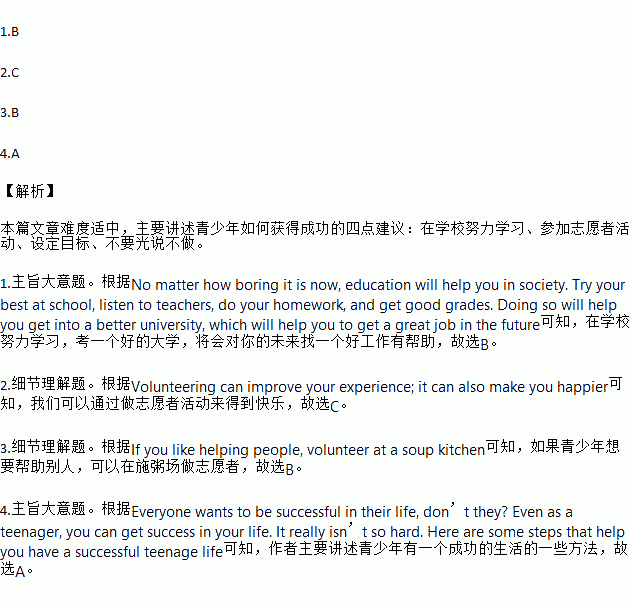题目内容
Everyone wants to be successful in their life, don’t they? Even as a teenager, you can get success in your life. It really isn’t so hard. Here are some steps that help you have a successful teenage life.
★______________________
No matter how boring it is now, education will help you in society. Try your best at school, listen to teachers, do your homework, and get good grades. Doing so will help you get into a better university, which will help you to get a great job in the future.
★Do good in your free time.
Volunteering can improve your experience; it can also make you happier. Find volunteer opportunities(机会) that interest you. For example, if you love animals, volunteer at an animal center. If you like helping people, volunteer at a soup kitchen. If you love helping the environment, plant trees or pick up litter. When you help others, it will make you feel better about yourself. Having lots of volunteer hours will look good on your resume (履历)!
★Find out your goals(目标) in life and work towards them.
Start thinking about jobs you would like to get, and make a good choice according to your interests. Challenge yourself and you’ll be surprised at what you can do after you finish a hard job!
★Get active!
Join a sports team at school or out of school. Just exercise! Studies show that people who get active in their child / teen years will be more active when they’re adults, so start getting active now.
1.________ might be the best one to put in the blank in the passage.
A. Get up early. B. Do well in school.
C. Believe in something. D. Do whatever you like.
2.According to the passage, volunteering can help people to get ________.
A. quieter B. bored C. happier D. knowledgeable
3.If teenagers want to help people, they can volunteer ________.
A. at an animal center B. at a soup kitchen
C. to clean up litter D. to plant trees and flowers
4.In the passage, The writer mainly tells us some ways to ________.
A. have a good teenage life B. make a good choice
C. get active in child years D. have a good job and life
 天天向上一本好卷系列答案
天天向上一本好卷系列答案 小学生10分钟应用题系列答案
小学生10分钟应用题系列答案Simple things that are super complex
● Defining (定义) the word “the” is really difficult.
The word “the” is one of the most common words in the English language and most of us have probably never stopped to think about how strange of a word it actually is. A dictionary lists more than twenty different ways the word can be used in a sentence correctly, which makes an exact definition of the word much more difficult to explain.
● There’s no theory (理论) accepted by everyone on how bikes work.
Bicycles have existed (存在) for over 100 years, and scientists have been discussing about how exactly they work, or more specifically, how they stay upright, almost since they were first invented. But there’s no exact answer to it. And because bicycle dynamics (动态) isn’t exactly an area of science into which researchers like to spend time, it’s highly impossible that we’ll know for sure anytime soon.
● Yawning (打哈欠)
Yawning is a puzzling phenomenon (现象). Even that act of talking about it is simple enough to make some people do it. There is really no other bodily function quite like it. In fact, there is no theory for we yawn, which is agreed upon by everyone. As for why yawning is contagious (传染), no one knows that either.
阅读以上信息,用恰当的词完成下面的表格,每空一词。
The word “the” | ● It is one of the most words in English language, most of us 1. on thinking about the word. ● There are 2. twenty different ways of its usage in the dictionary, it is still difficult to make an exact definition of this word. |
Bicycle | ● Bicycle have existed for over 100 years and have been 3. how exactly they work. ● Researchers don’t like to spend time on how bicycles and 4. react to each other. |
Yawning | ● It’s a puzzling phenomenon which is simple enough to make some people do while talking about it. ● No other bodily function is like yawning. ● No one knows the 5. — why yawning is contagious. |


 B.
B.  C.
C.  D.
D. 